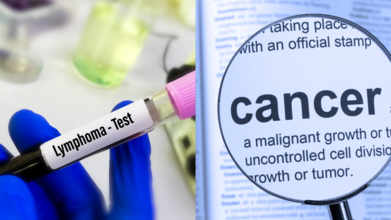- Health Conditions A-Z
- Health & Wellness
- Nutrition
- Fitness
- Health News
- Ayurveda
- Videos
- Medicine A-Z
- Parenting
- Web Stories
Persistent Nausea After Meals? For This Canadian Woman, It Was Not IBS — It Was Stage 4 Cancer

When 26-year-old Shannin Pain from Kawartha Lakes, Canada, began experiencing persistent nausea after meals, along with sharp cramps and an inability to keep food down, she did what most of us would do: she went to the doctor. But instead of getting clarity, she got dismissed.
What followed was a frustrating tour of diagnoses that did not stick: IBS, coeliac disease, Crohn’s, even haemorrhoids. Everyone had a theory, except no one ordered the one test that could have saved her life: a colonoscopy.
I Knew Something Was Wrong
“I was told it was IBS or anxiety,” Shannin told the Express UK. But her gut literally was screaming that it was not normal. By October 2023, her symptoms had gone from uncomfortable to terrifying. Her bowel habits had changed drastically, her stool had become pencil-thin, and post-meal nausea was relentless.
And then came the pain. “I'd get these stabbing cramps in my lower left abdomen – so bad I couldn't breathe. I would double over, gasping, clutching my stomach. It felt like something was ripping through me.”
What makes her story especially heartbreaking is not just the physical suffering but how medical professionals repeatedly overlooked her pleas, perhaps because of her age; too young, they assumed, for something as “unlikely” as colorectal cancer.
The MRI That Changed Everything
In April 2024, after six months of worsening symptoms and no answers, doctors finally decided to order an MRI just to rule things out, according to the Express UK. Shannin never went home after that scan.
The MRI revealed a complete intestinal blockage. Emergency surgery followed, and when she woke up, she was hit with the words no one wants to hear: it was cancer.
Stage 4 colorectal cancer, to be precise. The tumour had blocked her colon, spread to her right ovary (a Krukenberg tumour), invaded 11 of 13 lymph nodes, and scattered across her peritoneum. Worse, her liver was so riddled with tumours that surgery was not an option.
Fighting for Her Life
Facing a terminal diagnosis, Shannin had to act fast. Doctors gave her a brutal choice: without chemotherapy, she had less than three months to live. With treatment, maybe three years.
But even in the face of such devastation, she fought for her future, freezing seven eggs in May 2024 before chemotherapy threatened her fertility.
She has now undergone 27 rounds of chemotherapy and is preparing for her 28th. Along the way, she has endured near-death anaphylactic reactions to the drugs and a relentless treatment schedule. And yet, amid it all, a tiny glimmer: her latest scan showed no new growths.
When Dismissal Is Deadly
Shannin’s story is not just about a rare and aggressive cancer. It is about how easy it is to miss something when symptoms are brushed off as “too common” or the patient “too young.”
Colorectal cancer is one of the most preventable and treatable cancers if it is caught early. But that requires one thing: being taken seriously. A colonoscopy is not a last resort. It is a simple test that could have changed Shannin’s trajectory, had it been done in time.
UK Issues Slushie Warning: Why This Summer Favourite Could Be Risky for Kids

Just as British summer hits full swing, the UK’s Food Standards Agency (FSA) has dropped a warning: slushies may not be so child-friendly after all. In an urgent new advisory, the FSA has warned parents to steer clear of giving slush ice drinks to children under seven, especially those containing a chemical called glycerol. And for kids between seven and ten? Keep it to a strict 350 ml a day.
What’s So Dangerous About a Slushie?
Slushies may seem like they beat the heat, but beneath that colour lies a syrupy science experiment. Most commercial slush drinks get their signature texture from glycerol, a compound that keeps ice from freezing into one giant block and gives slushies their semi-liquid, chewable charm. The trouble is, glycerol is harmful when consumed in large quantities, especially by small bodies.
According to the FSA, excessive intake of glycerol in a short span can cause mild symptoms like nausea, headaches and vomiting. But in more severe cases, children can suffer from dangerously low blood sugar, go into shock, or even lose consciousness.
The Risks Are Real and Rising
This warning did not come out of nowhere. The FSA has seen a surge in reports of children collapsing after drinking slushies. In many of these cases, the affected kids had consumed slush drinks in large amounts over a short period.
Summer’s New Parenting Rule
The FSA is urging parents and carers to be vigilant. Before buying a slushie, they recommend asking vendors whether the drink contains glycerol. If you are not sure, play it safe, especially with younger kids. Parents should also keep an eye on home-use slush kits and ready-to-drink slush pouches, which may also include this ingredient.
The shops have now also been instructed to stop offering free slushie refills for children under 10 and to use the minimal amount of glycerol necessary to get that slushy texture.
What to Do If a Slushie Turns Sour
If your child starts feeling queasy or dizzy after downing a slushie, do not panic, but do act. In mild cases, giving them a sugary snack or drink can help stabilise blood sugar levels. But if your child seems lethargic, confused, or unresponsive, call 999 immediately. It is better to be overly cautious than to risk a serious health episode.
Slushie Season, But Make It Safer
This new advice arrives just ahead of the school summer holidays, the peak slushie season in the UK. As temperatures soar, these icy drinks will be everywhere. The message from the FSA is clear: slushies are not forbidden, but they are not harmless either. Especially when they are packed with glycerol and served up to tiny tummies.
World-First Online Calculator by UK Scientists Helps Predict Relapse in Hodgkin Lymphoma Patients; Here is How It Works

Scientists from the UK and the US have developed the world’s first online calculator that predicts whether a rare blood cancer—Hodgkin lymphoma—is likely to return within two years of treatment. And it involves just science, numbers, and 20 years of painstaking research.
The tool, known as E-HIPI (Early-stage Hodgkin Lymphoma International Prognostication Index), is a serious game-changer. Built using data from more than 5,000 patients involved in international clinical trials, it is the first risk model of its kind designed specifically for early-stage classic Hodgkin lymphoma (cHL)—a cancer that messes with your lymphatic system by attacking your white blood cells.
What it does and how it works
E-HIPI draws on real clinical data, everything from a patient’s sex and tumour size to their haemoglobin and albumin levels. In less than a minute, it can give clinicians a pretty reliable sense of how likely a patient is to relapse within two years of completing treatment.
Why this matters
Hodgkin lymphoma is one of the more treatable cancers, especially when caught early. But for a significant number of patients, the disease comes back and often with a vengeance. When a relapse happens, it usually means the patient has to go through more aggressive treatments like high-dose chemotherapy or even a stem cell transplant, which come with higher risks, longer recovery times, and a bigger emotional toll.
So having a tool like E-HIPI that gives doctors and patients a heads-up about the risk of relapse is more than just helpful; it could literally be lifesaving.
The serious side of a relapse
A relapse of Hodgkin lymphoma can be brutal. It means starting all over again, often with more intensive and targeted treatment. In some cases, patients who have relapsed also have a harder time responding to therapy, and their prognosis may not be as favourable the second time around.
That is why identifying high-risk patients early is so crucial. With E-HIPI, doctors can now tailor treatment more precisely, opting for more aggressive care for those who need it and sparing others from unnecessary side effects.
From Manchester to New Jersey: a global effort
E-HIPI is the product of a remarkable international collaboration. Scientists and clinicians from the University of Manchester and The Christie NHS Foundation Trust joined forces with top institutions in the US like RWJBarnabas Health, Rutgers Cancer Institute, and Tufts Medical Center.
Co-author of the study and Professor John Radford, Professor of Medical Oncology at The University of Manchester and Consultant Medical Oncologist at The Christie NHS Foundation Trust, told the Express UK: "This is the culmination of two decades of work. We wanted to find a better way to predict the outcome of people with early-stage Hodgkin lymphoma following treatment."
He added: "Until now we have lacked a robust tool, but we can now forecast how well individual patients are likely to respond to treatment, offering hope for more tailored and effective therapies. Crucially, the new tool can estimate a patient's likelihood of remaining cancer-free two years after treatment, which is a real game-changer. For some patients, it may mean avoiding overtreatment and its long-term side effects. For others, it may flag the need for closer monitoring or more intensive therapy."
'Pretty Little Baby' Singer Connie Francis Passes Away At 87, What Happened To Her?

Credits: Wikimedia Commons
Legendary pop singer Connie Francis, whose voice defined an era with heartbreak ballads and upbeat rock-n-roll hits, has died at the age of 87. Her publicist and longtime friend, Ron Roberts, confirmed the news on Facebook on Thursday, writing:
“It is with a heavy heart and extreme sadness that I inform you of the passing of my dear friend Connie Francis last night. I know that Connie would approve that her fans are among the first to learn of this sad news.”
Though the cause of her death has not yet been made public, Francis had been hospitalized just two weeks earlier for what she described as “extreme pain” due to a pelvic fracture. The beloved singer had kept fans updated about her health condition through heartfelt posts on social media.
Health Struggles in Her Final Days
On July 2, Francis shared that she had been hospitalized in Florida, undergoing tests to identify the cause of her pain. Her updates were filled with optimism, despite having been moved to the intensive care unit and missing a scheduled appearance on Cousin Brucie’s Independence Day radio show.
By July 3 and 4, Francis posted that she was “feeling much better,” and expressed gratitude for her supporters. However, she remained under medical observation, and in a post the following week, she revealed that doctors were still trying to get to the root of her condition.
This wasn’t her first health battle.
In May, Francis had shared that she had suffered a hip injury that left her temporarily wheelchair-bound. Her openness about her condition made her all the more endearing to longtime fans who had followed her through the highs and lows of both her professional and personal life.
A Trailblazing Career That Crossed Borders and Genres
Born Concetta Rosa Maria Franconero in 1937, Connie Francis rose to fame in the late 1950s with her breakthrough hit “Who’s Sorry Now,” a song that she famously performed on television after nearly being dropped by her label. The track became a massive hit, charting internationally and setting the stage for a string of chart-topping singles.
She followed with hits like “Stupid Cupid,” “Lipstick on Your Collar,” “Don’t Break the Heart That Loves You,” and the carefree anthem “Vacation.” Her clear, emotional voice resonated with millions and helped her bridge musical genres—from rock ’n’ roll and country to standards and international ballads.
Francis sang in more than a dozen languages, including Italian, Yiddish, and Swedish, and found global success at a time when international stardom was rare for American artists. Her versatility and emotional range made her one of the best-selling female pop stars of her generation.
A Social Media Resurgence in Recent Years
In the digital age, Connie Francis found renewed fame among younger audiences thanks to social media platforms like TikTok and Instagram Reels. Her 1965 song “Pretty Little Baby” became a viral favorite, introducing her music to a new generation and reminding the world of her timeless appeal.
© 2024 Bennett, Coleman & Company Limited

